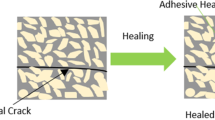Abstract
Asphalt paving composites normally contain about 6 percent of a bituminous hydrocarbon binder and the remainder an inorganic aggregate comprising particles of sand, crushed rock, limestone or other minerals which may be indigenous to a particular region. Although it is recognized that prolonged exposure of asphalt pavements to moisture can cause a pronounced loss of strength and accelerate the deterioration of road surfaces, there does not appear to be any generally acceptable solution to the problem.1, 2
Preview
Unable to display preview. Download preview PDF.
Similar content being viewed by others
References
J. A. N. Scott, “Adhesion and Disbonding Mechanisms of Asphalt....,” Association of Asphalt Paving Technologists, Conference Proceedings, February 13 – 15, 1978.
R. I. Hughes, D. R. Lamb and 0. Pordes, “Adhesion in Bitumen Macadam,” J. Appl. Chem., 10, 433 – 444 (1960).
H. J. Fromm, “The Mechanisms of Asphalt Stripping from Aggregate Surfaces,” Proc. Assoc. Asphalt Paving Technol., 43, 191 – 206 (1974).
L. Ciplijauskas, M. R. Piggott and R. T. Woodhams., I and E. C. Product Research and Development,18, 86 – 91 (1979).
J. Shim-Ton, “Adhesion of Asphalt to Glass,” Department of Chemical Engineering and Applied Chemistry, University of Toronto, M.A.Sc. thesis, 1981.
J. A. Di Vito and G. R. Morris, “Silane Pretreatment of Mineral Aggregate to Prevent Stripping,” Proceedings Transportation Research Board Meeting, January, 1982.
D. W. van Krevelyn and P. J. Hoftyzer, Properties of Polymers, Elsevier, pp. 168 – 171 (1976).
A. J. Kinloch, W. A. Dukes and R. A. Gledhill, “Durability of Adhesive Joints,” Preprints ACS Coatings and Plastics Div., 35 (1), 546 – 559 (1975).
D. W. Kirk and D. F. Othmer, Encyclopedia of Chemical Technology, Interscience Publ.,13, 727 – 734 (1965).
L. Holland, “The Properties of Glass Surfaces,” Chapman and Hall, London, 1966.
E. E. Gilbert, Sulfonation and Related Reactions, Interscience Publ., 1965.
A. W. Neumann and R. J. Good, “Techniques of Measuring Contact Angles,” Plenum Press, pp. 31 – 91 (1979).
S. Varevorakul, “Adhesion Promoters for Bitumen,” Department of Chemical Engineering and Applied Chemistry, University of Toronto, B.A.Sc. thesis, 1981.
R. K. Iler, “The Colloid Chemistry of Silica and Silicates,” Cornell University Press, pp. 249 – 252 (1955).
Author information
Authors and Affiliations
Editor information
Editors and Affiliations
Rights and permissions
Copyright information
© 1984 Plenum Press, New York
About this chapter
Cite this chapter
Shim-Ton, J., Varevorakul, S., Woodhams, R.T. (1984). Iron Compounds as Adhesion Promoters for Bitumen. In: Kresta, J.E. (eds) Polymer Additives. Polymer Science and Technology, vol 26. Springer, Boston, MA. https://doi.org/10.1007/978-1-4613-2797-4_27
Download citation
DOI: https://doi.org/10.1007/978-1-4613-2797-4_27
Publisher Name: Springer, Boston, MA
Print ISBN: 978-1-4612-9724-6
Online ISBN: 978-1-4613-2797-4
eBook Packages: Springer Book Archive




